D?m?si P., Nehaniv C.L. Algebraic Theory of Automata Networks. An Introduction
Подождите немного. Документ загружается.

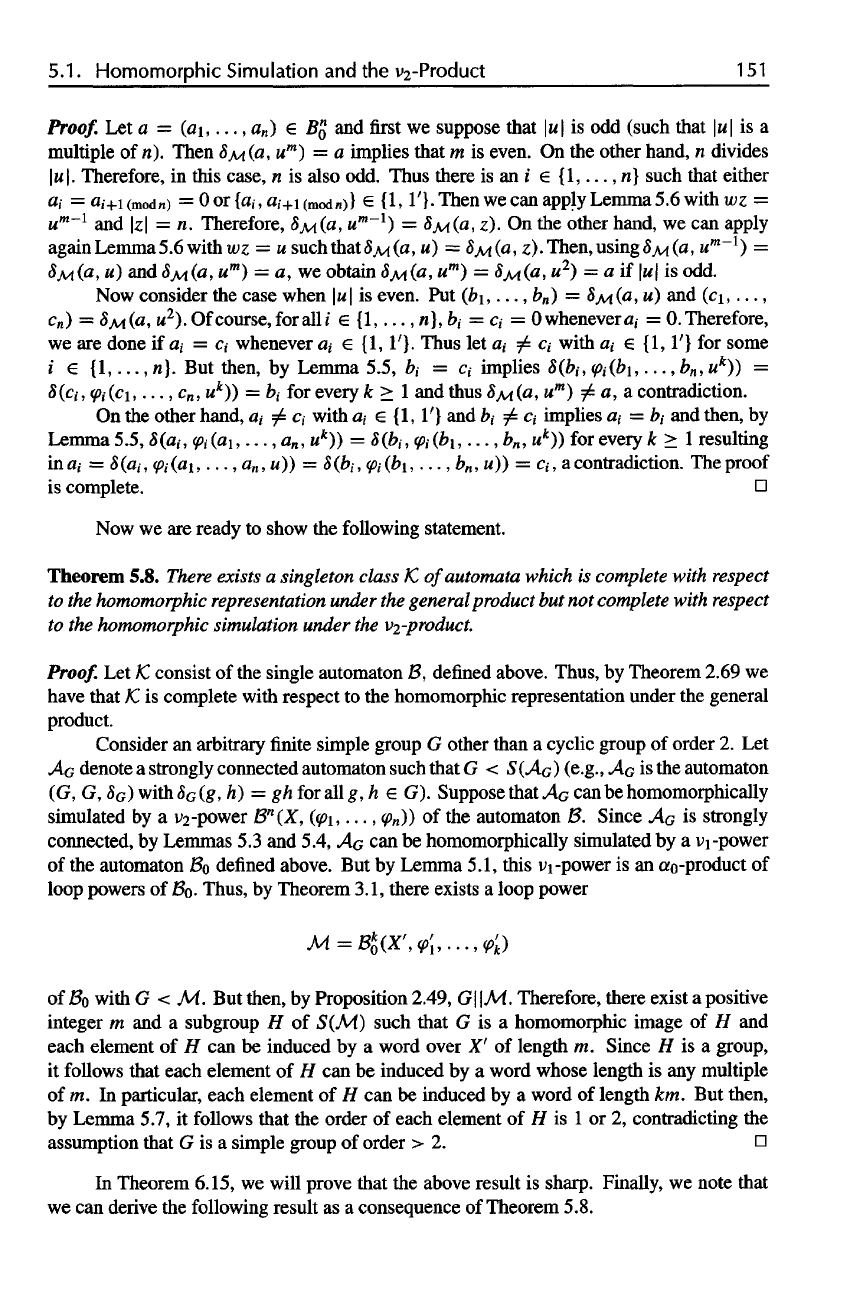
5.1. Homomorphic Simulation
and the
V2-Product
1 51
Proof.
Let a =
(a\,...,
a
n
) B
n
o
and first we
suppose that
|u| is odd
(such that
\u\ is a
multiple
of n).
Then
S
M
(a,
u
m
) = a
implies that
m is
even.
On the
other hand,
n
divides
\u\. Therefore,
in
this case,
n is
also odd. Thus there
is an i
{1,...,n} such that either
a
i
=
ai+1mod
n)
= O
or{a
i,
a
j+1(m0d
n)
}
{1,1'}.
Then
we can
apply Lemma
5.6
with
wz =
u
m
~
l
and |z| = n.
Therefore,
M
(a,
u
m-1
)
=
M
(a,
z). On the
other hand,
we can
apply
again Lemma
5.6
with
wz = u
such that
M
(a, u) =
M(
a,
z).
Then, using
M
(a,
u
m
~
l
)
=
M
(
a,
u)
and
8
M
(a,
u
m
} = a, we
obtain
M
(a,
u
m
) =
M
(
a,
u
2
) = 0 if |u| is
odd.
Now
consider
the
case when
\u\ is
even.
Put
(b
\
,...,
b
n
) =
M
(a,
M)
and
(c
1
,...,
c
n
)
=
M
(a,
u
2
).
Of
course,
for
alli
{1,...,
n}, b
i
= c, =
O
whenever
a
i
,
= 0.
Therefore,
we
are
done
if a
i
, = c
i
,
whenever
a, {1,
1'}• Thus
let a
i
, c
i
,
with
a
i
, €
{1,1'}
for
some
i
{1,...,
n}. But
then,
by
Lemma 5.5,
b
i
, = c
i
,
implies
8(b
i
,
i(b
1
,
...,b
n,
u
k
))
=
8(C
i
,
i
(CI,...,
c
n
,
u
k
))
= b
i
for
every
k 1 and
thus
M
(a,
u
m
) a, a
contradiction.
On
the
other hand,
a
i
c
i
,
with
a
i
, {1, 1'} and b
i
c
i
,
implies
a
i
, = b
i
and
then,
by
Lemma 5.5,
8
(a
i,
(a
1,
,a
n
,
u
k
))
=
5(b
i
,
i
(b
1
, -..,b
n
,
u
k
)}
for
every
k: 1
resulting
in
a
i
,
=
(a
i
,
(a
1
,...,
a
n
, u)) =
8(b
i
, i(b\,
...,b
n
,
u)) =
c,-,
a
contradiction.
The
proof
is
complete.
Now
we are
ready
to
show
the
following statement.
Theorem
5.8.
There
exists
a
singleton class
K,
of
automata
which
is
complete
with
respect
to
the
homomorphic
representation
under
the
general
product
but not
complete
with
respect
to the
homomorphic
simulation under
the
v
2
-product.
Proof.
Let k
consist
of the
single automaton
B,
defined
above. Thus,
by
Theorem 2.69
we
have
that
K. is
complete
with
respect
to the
homomorphic representation under
the
general
product.
Consider
an
arbitrary
finite
simple group
G
other than
a
cyclic group
of
order
2. Let
AG
denote
a
strongly connected automaton such that
G <
S(A
G
)
(e.g.,
A
G
is the
automaton
(G,
G,
G
)
withS
G
(g,
h) = gh
for
all g, h G).
Suppose that
A
G
can be
homomorphically
simulated
by a
V
2
-power B
n
(X,
(
\
,...,
n
)) of the
automaton
B.
Since
A
G
is
strongly
connected,
by
Lemmas
5.3 and
5.4,
A
G
can be
homomorphically simulated
by a
v
1
-power
of
the
automaton
B
o
defined
above.
But by
Lemma 5.1, this
PI-power
is an
a
o
-product
of
loop powers
of B
o
.
Thus,
by
Theorem 3.1, there exists
a
loop power
of
B
o
with
G < M. But
then,
by
Proposition
2.49,
G| |M.
Therefore, there exist
a
positive
integer
m and a
subgroup
H of
S(M) such that
G is a
homomorphic image
of H and
each element
of H can be
induced
by a
word over
X' of
length
m.
Since
H is a
group,
it
follows that each element
of H can be
induced
by a
word whose length
is any
multiple
of
m. In
particular, each element
of H can be
induced
by a
word
of
length
km. But
then,
by
Lemma 5.7,
it
follows that
the
order
of
each element
of H is 1 or 2,
contradicting
the
assumption that
G is a
simple group
of
order
> 2.
In
Theorem 6.15,
we
will prove that
the
above result
is
sharp. Finally,
we
note that
we
can
derive
the
following result
as a
consequence
of
Theorem 5.8.
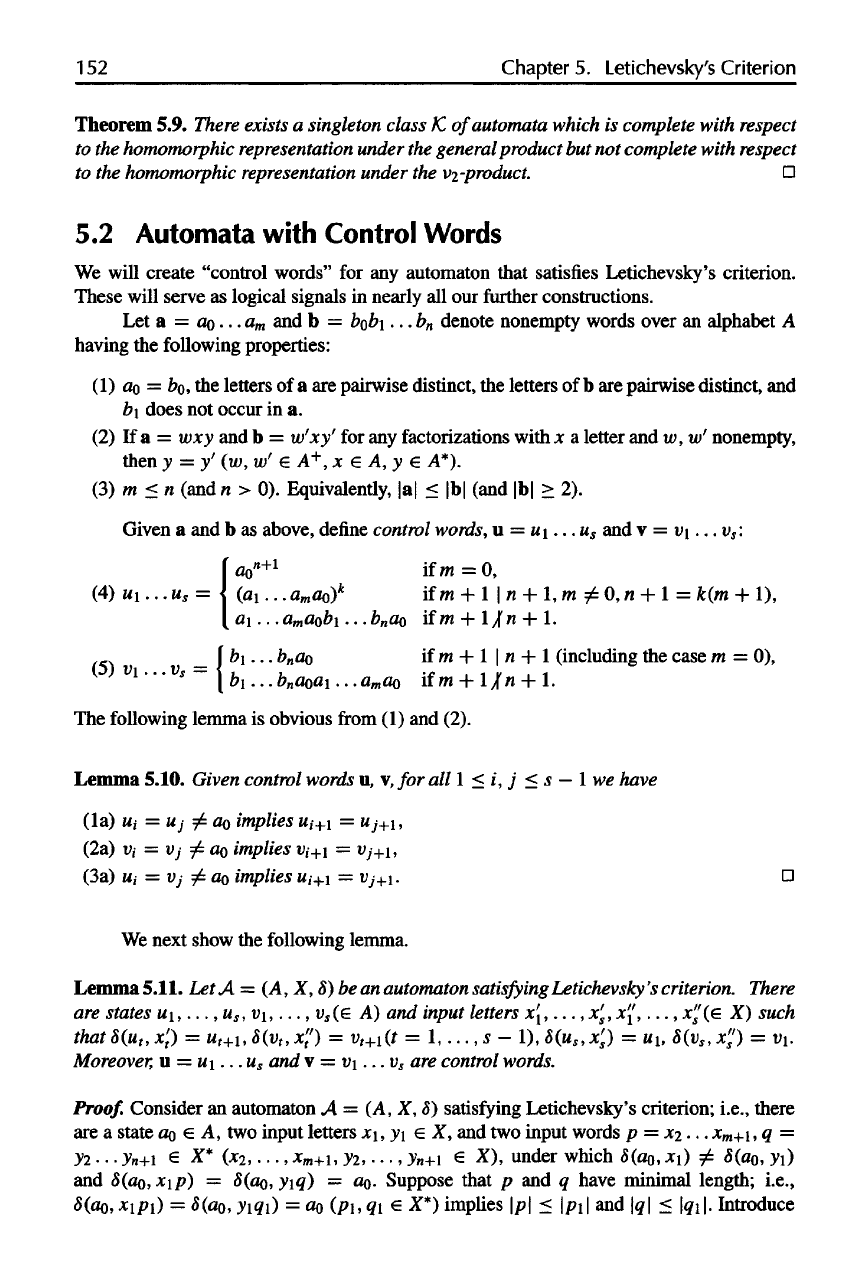
1
52
Chapter
5.
Letichevsky's Criterion
Theorem 5.9.
There
exists
a
singleton class
1C
of
automata
which
is
complete
with
respect
to the
homomorphic
representation
under
the
general
product
but not
complete
with
respect
to
the
homomorphic
representation
under
the
v
2-product.
5.2
Automata
with
Control
Words
We
will create "control words"
for any
automaton that satisfies Letichevsky's criterion.
These will serve
as
logical signals
in
nearly
all our
further
constructions.
Let
a = a
o
... a
m
and b =
b
o
b
\
...b
n
denote nonempty words over
an
alphabet
A
having
the
following properties:
(1)
a
o
= b
o
, the
letters
of a are
pairwise distinct,
the
letters
of b are
pairwise distinct,
and
b\
does
not
occur
in a.
(2)
If a =
w
xy and b =
w'xy'
for any
factorizations with
x a
letter
and w, w'
nonempty,
then
y = y' (w, w' A
+
, x A, y
A*).
(3)
m n
(and
n > 0).
Equivalently,
|a| |b|
(and
|b| 2).
Given
a and b as
above,
define
control
words,
u =
u\...
u
s
and v =
v
\
...
v
s
:
The
following lemma
is
obvious
from
(1) and
(2).
Lemma 5.10. Given
control
words
u, v, for all
we
have
implies
implies
implies
We
next show
the
following lemma.
Lemma 5.11.
Let A=
(A,X,8)
be an
automaton
satisfying
Letichevsky
's
criterion.
There
are
states
u
\
,...,
u
s
,
v
\
,...,
u
s
(€
A) and
input
letters
x
1
,
...,x'
s
,x",...,
x"( X)
such
that8(u
t
,x'
t
)
=
u
t+1
,8(v
t
,x
t
")
=
v
t
+\(t
=
1,....
s -
l),8(u
s
,x'
s
)
= u
1
,
8(v
s
,x")
= v..
Moreover,
u =
u
\
...
u
s
and
v =
v
\
...
v
s
are
control
words.
Proof.
Consider
an
automaton
A = (A, X, 8)
satisfying Letichevsky's criterion; i.e., there
are
a
state
a
o
A, two
input letters
x
1
, y
1
€ X, and two
input words
p =
X
2
...
x
m+\
,
q =
y
2
...
y
n+1
X*
(x
2
,...,
x
m
+1,
y
2
, • • •,
y
n+1
X},
under which 8(a
o
,
x
1
)
8(a
o
,
y
1
)
and
8(an,x
1
p)
=
(an,y\q}
= an.
Suppose that
p and q
have minimal length;
i.e.,
implies
and
Introduce
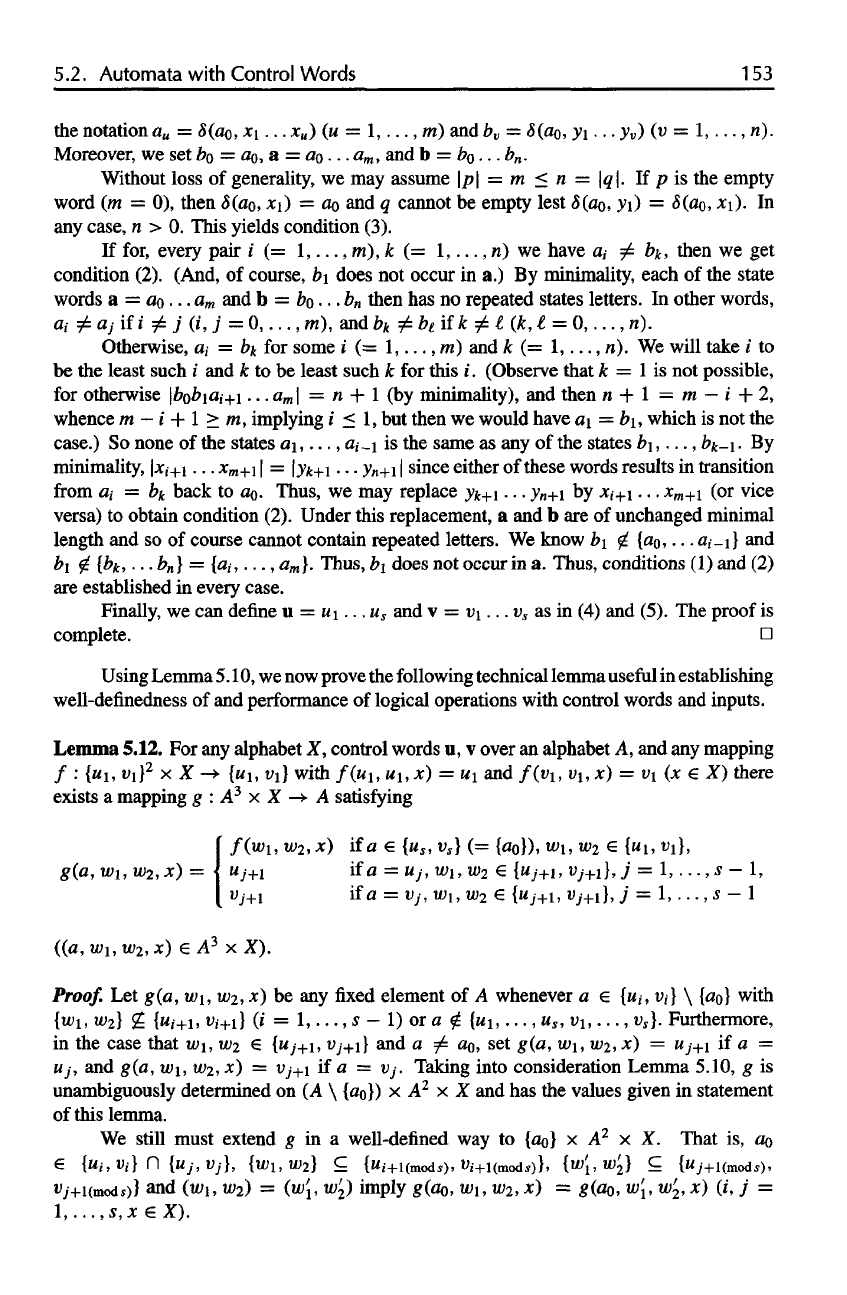
5.2.
Automata with Control Words
153
the
notation
a
u
=
S(a
o
,
x
\
...
xu
) (u =
1,...,
m)
and
b
v
=
(a
o
, j
1
...
j
v
) (v =
1,...,
n).
Moreover,
we set
b
o
= a
o,
a = a
0
• • • a
m,
and b =
b
o
...
b
n
.
Without
loss
of
generality,
we may
assume
\p\ = m n =
\q\.
If p is the
empty
word
(m = 0),
then (a
o
,
x
1
) = a
o
and q
cannot
be
empty lest (a
o
,
y
1
) =
(a
o
, x
1
).
In
any
case,
n > 0.
This yields condition (3).
If
for, every pair
i (=
1,...,
m), k (=
1,...,
n) we
have
a
i
, b
k
.
then
we get
condition (2). (And,
of
course,
b\
does
not
occur
in a.) By
minimality, each
of the
state
words
a = a
o
... a
m
and b =
b
o
...
b
n
then
has no
repeated states letters.
In
other words,
and
utnerwise,
a
i
, = b
k
tor
some
i (=
i,...,
m) ana
K
(=
i,...,
n). we win
taKe
i to
be
the
least such
i and k to be
least such
k for
this
i.
(Observe that
k = 1 is not
possible,
for
otherwise
\b
o
b
\
a
i
+1..
.a
m
\
= n + 1 (by
minimality),
and
then
n + 1 = m
—
i + 2,
whence
m - i + 1 m,
implying
i 1, but
then
we
would have
a\
=b
\
, which
is not the
case.)
So
none
of the
states
a
\
,...,
a,_i
is the
same
as any of the
states
b
\
,..., b
k-\
.
By
minimality,
\Xi+\...
x
m
+\
\ = \
y
k+1
...
y
n+1
I
since
either
of
these
words
results
in
transition
from
a, = b
k
back
to a
o
.
Thus,
we may
replace
y
k+1
...
y
n+1
by
x
i+1
...
x
m+\
(or
vice
versa)
to
obtain condition (2). Under this replacement,
a and b are of
unchanged minimal
length
and so of
course cannot contain repeated letters.
We
know
b\ {a
o
• • •
a
i
-
1
}
and
b
\
{bk,...
b
n
} =
{a
i
,,...,
a
m
}. Thus,
b
\
does
not
occur
in a.
Thus,
conditions
(1) and (2)
are
established
in
every case.
Finally,
we can
define
u =
U\
.
..U
S
and v =
v
\
...
v
s
as in (4) and
(5).
The
proof
is
complete.
Using Lemma 5.10,
we now
prove
the
following technical lemma
useful
in
establishing
well-definedness
of and
performance
of
logical operations with control words
and
inputs.
Lemma 5.12.
For any
alphabet
X,
control words
u, v
over
an
alphabet
A, and any
mapping
f ;
{MI,
v
i,
}
2
x X
—>
{u
1
,
v
1
}
with f(u
1
,
u
1
, x) = u\ and
f(v\, v\,x)
= v\ (x X)
there
exists
a
mapping
g : A
3
x X A
satisfying
Proof.
Let
g(a,
w
\
,
W
2
,x)
be any fixed
element
of A
whenever
a
{u
i
, v
i
,}
\
{a
o
} with
Furthermore.
in
the
case that w
\
,w
2
(u
i
,-u.
v,-u}
and a
set
if
a
and g
if
Taking
into consideration Lemma 5.10,
g is
unambiguously
determined
on (A \
{a
o
})
x A
2
x X and has the
values given
in
statement
of
this lemma.
We
still must extend
g in a
well-defined
way to
[a
0
]
x A
2
x X.
That
is, a
o
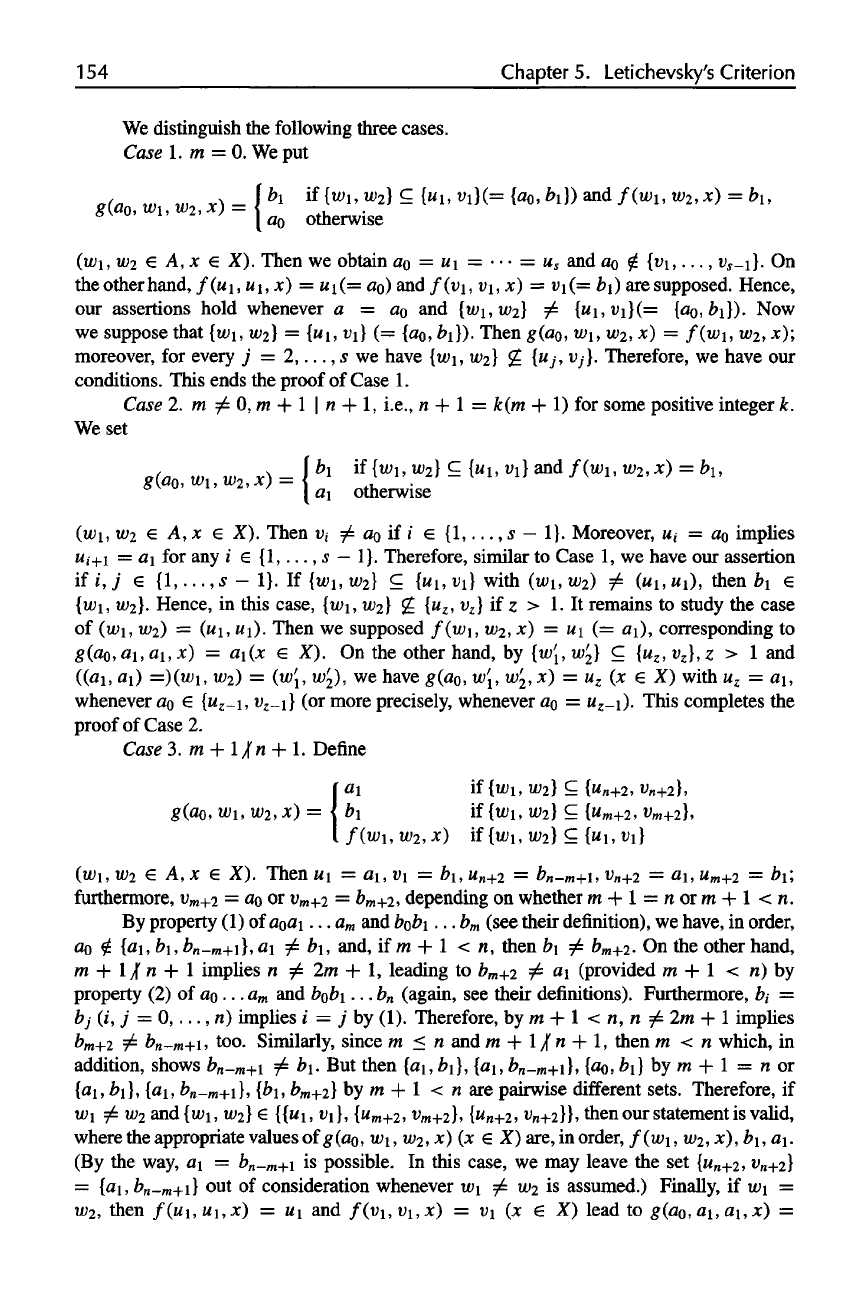
154
Chapter
5.
Letichevsky's
Criterion
We
distinguish
the
following three cases.
Case
1. m = 0. We put
(w
1
,
W
2
£ A, x 6 X).
Then
we
obtain
a
o
= u
\
= • • • = u
s
and a
0
{v
\
,...,
v
s
-\}.
On
the
other hand, f(u
1
,
u
1
, x) =
u
1
(=
a
o
) and
f(v
\
,
v
\
, x) =
v
1
(=
b
\
) are
supposed. Hence,
our
assertions hold whenever
a = a
o
and
{w
\
,W
2
}
{u
i
,v
1
}(=
{a
o
,b
\
}).
Now
we
suppose that {w
\
,
W
2
\ =
{u
1
,
v
1
) (=
{a
o
,b
1
})-
Then
g(a
o
,
w
\
,
W
2
,x)
=
f(w
\
, w
2
,x);
moreover,
for
every
j =
2,...,
s we
have {w
1
,
W
2
{U
j
, V
j
}. Therefore,
we
have
our
conditions. This ends
the
proof
of
Case
1.
Case
2. m
O,
m + 1 | n + 1,
i.e.,
n + 1 = k(m + 1) for
some positive integer
k.
We
set
and
otherwise
(w
1
,
W
2
A,x X).
Then
v
i
, a
o
if i
{1,...,
s — 1}.
Moreover,
u
i
, = a
o
implies
u
i+I
= a\ for any i
{1,...,
5
—
1}.
Therefore, similar
to
Case
1, we
have
our
assertion
if
i, j
{1,...
,s — 1). If
{w
1
,
W
2
{m, v
\
]
with (w
\
,
W
2
) (u
1
u
1
), then
b\
{]w
1
,
W
2
.
Hence,
in
this case, {w
\
,
W
2
{u
z
,
v
z
} if z > 1. It
remains
to
study
the
case
of
(w
\
,
W
2
) =
(u
1
, u
1
). Then
we
supposed f(w
\
,
W
2
, x) = u\ (=
a
\
), corresponding
to
g(a
o
,a\,a\,x)
=
a
\
(x
€ X). On the
other hand,
by
{w'
1,
w
2
}
(u
Z
,
v
z
},z
> 1 and
((a\,
a
\
)
=)(w
\
,
W
2
) =
(w
\
, w'
2
),
we
have g(a
o
,
w
1
,
w'
2
,
x) = u
z
(x X)
with
u
Z
= a\,
whenever
a
o
{M
Z
_I,
u
z
-i}
(or
more precisely, whenever
a
o
=
«z-i)-
This completes
the
proof
of
Case
2.
Case
3. m + 1 n + 1.
Define
(w
\,
w
2
€ A,x X).
Then
MI
= ai, vi = fci,
M
n+2
=
/?«-«+!,
v«+2
= a\,
u
m+2
= b\\
furthermore,
v
m+
2
= ao or
v
m+
2
=
b
m+
2,
depending
on
whether
m +
l=norm
+ l < n.
By
property
(1) of
aoai...
a
m
and
b$b\...
b
m
(see their
definition),
we
have,
in
order,
ao
[a
\
,
b\,
b
n
-
m+
i},
a\ b
\
,
and,
if m + 1 < n,
then
b\
b
m+
2.
On the
other hand,
m
+ / n + 1
implies
n 2m + 1,
leading
to
£
m+
2
a\
(provided
m + 1 < n) by
property
(2) of ao ... a
m
and bob
1
• • • b
n
(again,
see
their definitions). Furthermore,
b
i
=
bj
(i, j =
0,...,
n)
implies
i = j by
(1). Therefore,
by m + 1 < n, n 2m + 1
implies
b
m+
2
7
b
n
-
m
+i,
too. Similarly, since
m n and m + 1 + 1,
then
m < n
which,
in
addition, shows
b
n
-
m+
\
b\. But
then {a
\
, b
\
}, {a\,
b
n
-
m
+\},
{a
o
,
b
1
} by m + 1 = n or
{a
1
,
b
1
, {a
1
n-m+1 {b
1
,
b
m
+2)
by m + 1 < n are
pairwise
different
sets. Therefore,
if
w\ W
2
and{
w1
,
w
2
}
{u
1
, v\], {u
m+
2, v
m+
2}, [u
n+
2, v
n+
2}}, then
our
statement
is
valid,
where
the
appropriate values
of
g(a
o
,
w\, W
2
, x) (x X)
are,
in
order, f(w
\
,
W2,
x),b\,a\.
(By
the
way,
a\ =
b
n
-
m+
\
is
possible.
In
this case,
we may
leave
the set
{u
n+
2,
v
n
+2\
=
[a
\
,
b
n
-
m+1
}
out of
consideration whenever
w\ w
2
is
assumed.) Finally,
if w\ =
W2,
then f(u
1
, u
1
,*)
= u\ and
f(y
\
,v\,x)
= v\ (x 6 X)
lead
to
g(a
o
,a
1
,a\,x)
=
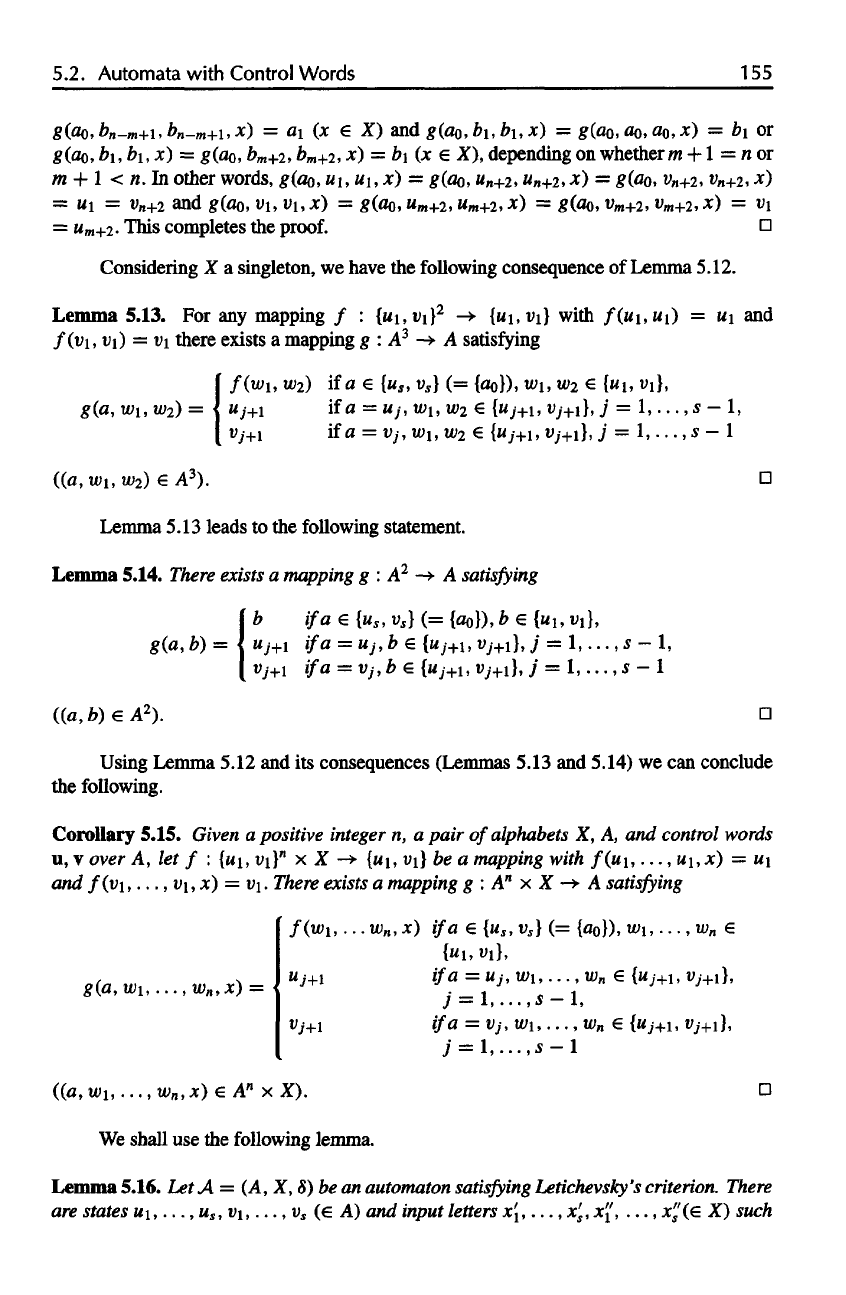
5.2.
Automata
with
Control Words
155
g(a
o
,b
n
-
m+
i,b
n
-
m+l
,x)
=
a
1
(x
X) and
g(a
o
,
b
1
,b
1
,x)
=
g(a
0
,
a
0
, a
o
, x) = b\ or
g(ao,
bi,bi,x)
=
g(ao,
b
m+2
,
b
m+2
,
x) = b\ (x X),
depending
on
whether
m +1 = n or
m
+ 1
<n..
In
other words, g(a
o
,
u
1
, u
1
, x) =
g(a
o
,
u
n+2
,
u
+2
,
x) = g
(a
o
,
v
n
+2,
u
n+2
,
x)
= u
1
=
u
n+2
and
g(a
0
,
v
\
,v
i
,x)
=
g(a
o
,
u
m
+2,
M
m+2
,
x) =
g(a
0
,
v
m
+2,
v
m+2
,
x) = v\
=
u
m+
2. This completes
the
proof.
Considering
X a
singleton,
we
have
the
following consequence
of
Lemma 5.12.
Lemma 5.13.
For any
mapping
/ :
{u\,v\}
2
{u
1
.UI}
with
f(u
1
,
u
1
) = u\ and
f(v\,
vi) = v\
there exists
a
mapping
g : A
3
A
satisfying
Lemma
5.13 leads
to the
following statement.
Lemma 5.14.
There
exists
a
mapping
g : A
2
A
satisfying
((a,b)
A
2
).
Using
Lemma 5.12
and its
consequences (Lemmas 5.13
and
5.14)
we can
conclude
the
following.
Corollary 5.15.
Given
a
positive
integer
n, a
pair
of
alphabets
X, A, and
control
words
u, v
over
A, let f :
{u
1
, v
1
}
n
x X
u
1
I,
v
1
} be a
mapping
with f(u
1
,
...,
u
1
, x) — u
\
and
f(v
\
,...,
v\, x) = v\.
There
exists
a
mapping
g : A
n
x X A
satisfying
((a,w
1
,...,w
n
,x)
A
n
x X).
We
shall
use the
following lemma.
Lemma 5.16.
Let A = (A, X, 5) be an
automaton
satisfying
Letichevsky's
criterion.
There
are
states
u
1
,
...,
u
s
,
v
\
,...,
v
s
( A) and
input
letters
x{,...,
x'
s
,
x",
...,
x"( X)
such
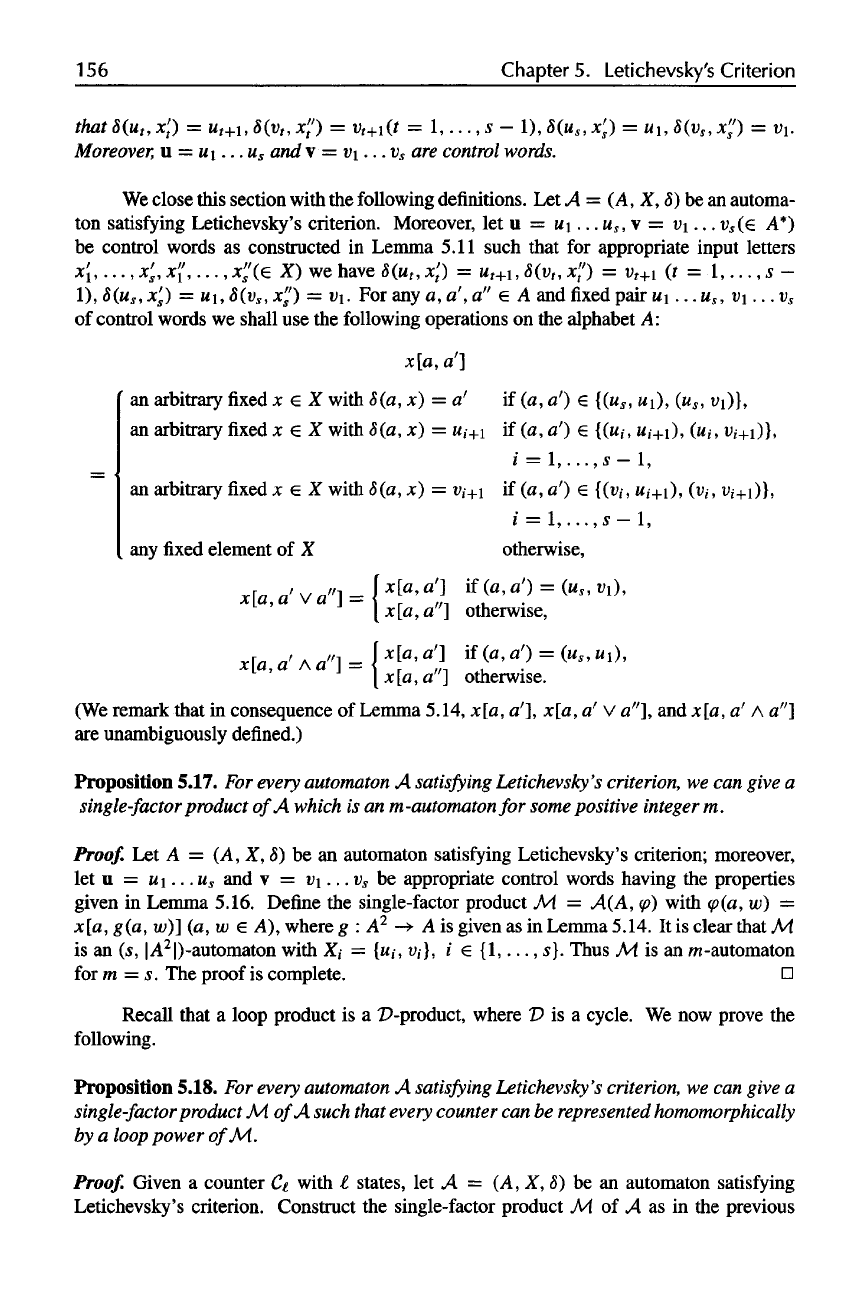
156
Chapters.
Letichevsky's
Criterion
that8(u
t
,x'
t
)
=
u
t
+i,8(vt,x")
=
v
t+
\(t
= 1,
...,s
-
l),8(u
s
,x'
s
)
=
u
1
,8(v
s
,x")
= v
\
.
Moreover,
u =
u
\
...
u
s
and
v =
v\...
v
s
are
control
words.
We
close this section with
the
following definitions.
Let A = (A, X, 8) be an
automa-
ton
satisfying Letichevsky's criterion. Moreover,
let u =
u\...
u
s
, \ =
v
1
...v
s
(
A*)
be
control words
as
constructed
in
Lemma 5.11 such that
for
appropriate input letters
x
1
{,...,
x'
s
,
x
f
{,...,
x'
s
'(
X) we
have 8(u
t
, x'
t
)
=
u
t+
i,
8(v
t
, x
t
")
=
v
t
+i
(t =
1,...,
s -
1),
8(u
s
,
x
s
) = u
1
,
8(v
s
,
x") = v
\
. For
any
a, a', a" A and
fixed
pair u
\
...
u
s
,
v
\
...
v
s
of
control words
we
shall
use the
following operations
on the
alphabet
A:
(We
remark that
in
consequence
of
Lemma 5.14,
are
unambiguously defined.)
and
Proposition
5.17.
For
every
automaton
A
satisfying
Letichevsky's criterion,
we can
give
a
single-factor
product
of
A
which
is an
m-automaton
for
some positive integer
m.
Proof.
Let A = (A, X, 5) be an
automaton satisfying Letichevsky's criterion; moreover,
let
u =
MI
... u
s
and v =
v
\
...
v
s
be
appropriate control words having
the
properties
given
in
Lemma 5.16. Define
the
single-factor product
M. =
A(A,
( )
with
(a, w) =
x[a, g(a,
w)] (a, w A),
where
g : A
2
A is
given
as in
Lemma 5.14.
It is
clear that
M.
is an (s,
|A
2
|)-automaton with
X
i
, =
{ui, v
i
,},
i
{1,...,
s}.
Thus
M. is an
m-automaton
for
m = s. The
proof
is
complete.
Recall that
a
loop product
is a
P-product,
where
D is a
cycle.
We now
prove
the
following.
Proposition
5.18.
For
every
automaton
A
satisfying
Letichevsky's criterion,
we can
give
a
single-factor
product
M.
of
A
such that
every
counter
can be
represented
homomorphically
by
a
loop
power
of
M.
Proof.
Given
a
counter
Cl
with
l
states,
let A = (A, X, 8) be an
automaton satisfying
Letichevsky's criterion. Construct
the
single-factor product
M. of A as in the
previous
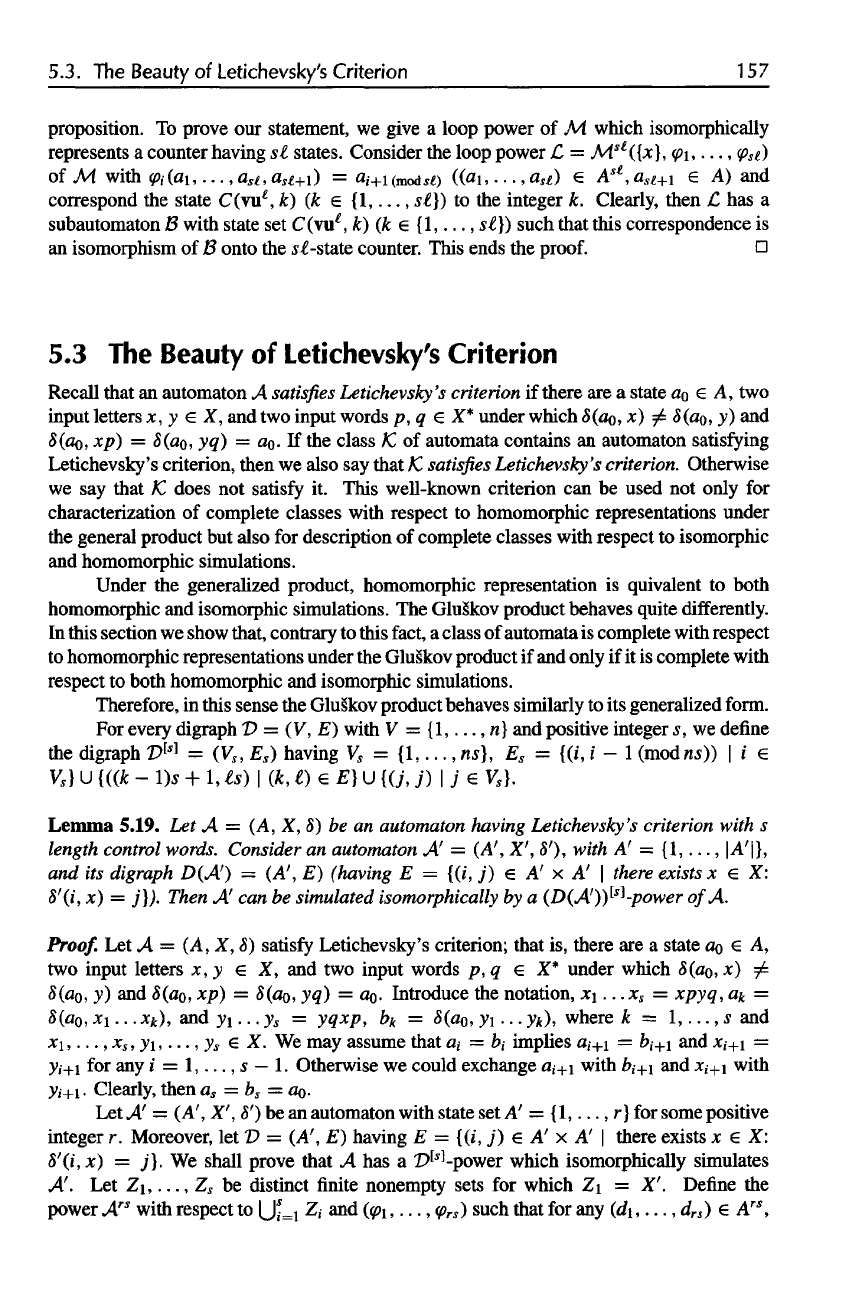
5.3.
The
Beauty
of
Letichevsky's Criterion
1 57
proposition.
To
prove
our
statement,
we
give
a
loop power
of M
which isomorphically
represents
a
counter having
sl
states.
Consider
the
loop power
£ =
M
sl
({x},
\
,...,
(
sl
)
of
M
with
(
i(a
1
,...,a
si
,a
sl
+i)
=
a
i+1(modsi
)
((a
{
,...
,a
si
)
e
A
sl
,a
sl+l
A) and
correspond
the
state C(vu
£
,
k) (k
{1,...,
si})
to the
integer
k.
Clearly, then
£ has a
subautomaton
B
with state
set
C(vu
£
,
k) (k
{1,...,
si}) such that this correspondence
is
an
isomorphism
of B
onto
the
5^-state counter. This ends
the
proof.
5.3 The
Beauty
of
Letichevsky's
Criterion
Recall
that
an
automaton
A
satisfies
Letichevsky's
criterion
if
there
are a
state
OQ
A, two
input
letters
x, y X, and two
input words
p, q X*
under which
S(a
o
,
x) =
(a
o
,
y) and
(a
0
,
x
p
) =
S(a
o
,
yq) = ao- If the
class
k of
automata contains
an
automaton
satisfying
Letichevsky's criterion, then
we
also
say
that
k
satisfies
Letichevsky's
criterion. Otherwise
we
say
that
k
does
not
satisfy
it.
This well-known criterion
can be
used
not
only
for
characterization
of
complete
classes
with respect
to
homomorphic representations under
the
general product
but
also
for
description
of
complete
classes
with respect
to
isomorphic
and
homomorphic simulations.
Under
the
generalized product, homomorphic representation
is
quivalent
to
both
homomorphic
and
isomorphic simulations.
The
Gluskov product behaves quite
differently.
In
this section
we
show that, contrary
to
this
fact,
a
class
of
automata
is
complete with respect
to
homomorphic representations under
the
GluSkov
product
if and
only
if it is
complete with
respect
to
both homomorphic
and
isomorphic simulations.
Therefore,
in
this sense
the
GluSkov
product behaves similarly
to its
generalized
form.
For
every digraph
D = (V, E)
with
V =
{1,...,n}
and
positive integer
s, we
define
the
digraph D
[s]
=
(V
s
,
E
s
)
having
V
s
=
{1,..., ns},
E
s
=
{(i,
i - 1
(modns))
I i
Lemma 5.19.
Let A = (A,
X,8)
be an
automaton
having
Letichevsky's
criterion with
s
length
control
words.
Consider
an
automaton
A =
(A',
X',
S'), with
A' =
{1,...,
|
A'|},
and
its
digraph
D(A)
=
(A',
E)
(having
E =
{(i,
j) A' x A' |
there
exists
x X:
S'(i,
x) =
j}).
Then
A can be
simulated
isomorphically
by a
(D(A))
[s
-power
of
A.
Proof.
Let A = (A, X, 8)
satisfy
Letichevsky's criterion; that
is,
there
are a
state
a
o
A,
two
input letters
x, y X, and two
input words
p, q X*
under which (a
o
,
x)
(a
o
y) and
8(a
o
,
xp) =
S(a
o
,
yq) = a
o
.
Introduce
the
notation,
jci...
x
s
=
xpyq,
ak
=
8(a
0
, x\... x
k
),
and
yi...
y
s
=
yqxp,
b
k
=
8(a
0
, y
i
... y
k
), where
k =
1,...,
s and
x\,...,
x
s
,
yi,...,
y
s
X. We may
assume that
0, =
b
i
{
implies
a,-+i
=
b
i+
\
and
x
i
,
+1
=
y
i
,+1
for any i =
1,...,
s — 1.
Otherwise
we
could exchange a
i
,
+1
with bi+\
and ,
+
i
with
y,-+1.
Clearly, then
a
s
= b
s
= a
o
.
Let
A =
(A',
X',
8')
be an
automaton with state
set A' =
{1,...,
r}
for
some positive
integer
r.
Moreover,
let D =
(A',
E)
having
E =
{(i,
j) A' x A' \
there exists
x 6 X:
8'(i,x)
= j}. We
shall prove that
A has a
D
[s]
-power which isomorphically simulates
A. Let
Zi,...,
Z
f
be
distinct
finite
nonempty sets
for
which
Zi = X'.
Define
the
power
A
rs
with
respect
to
and
such
that
for any
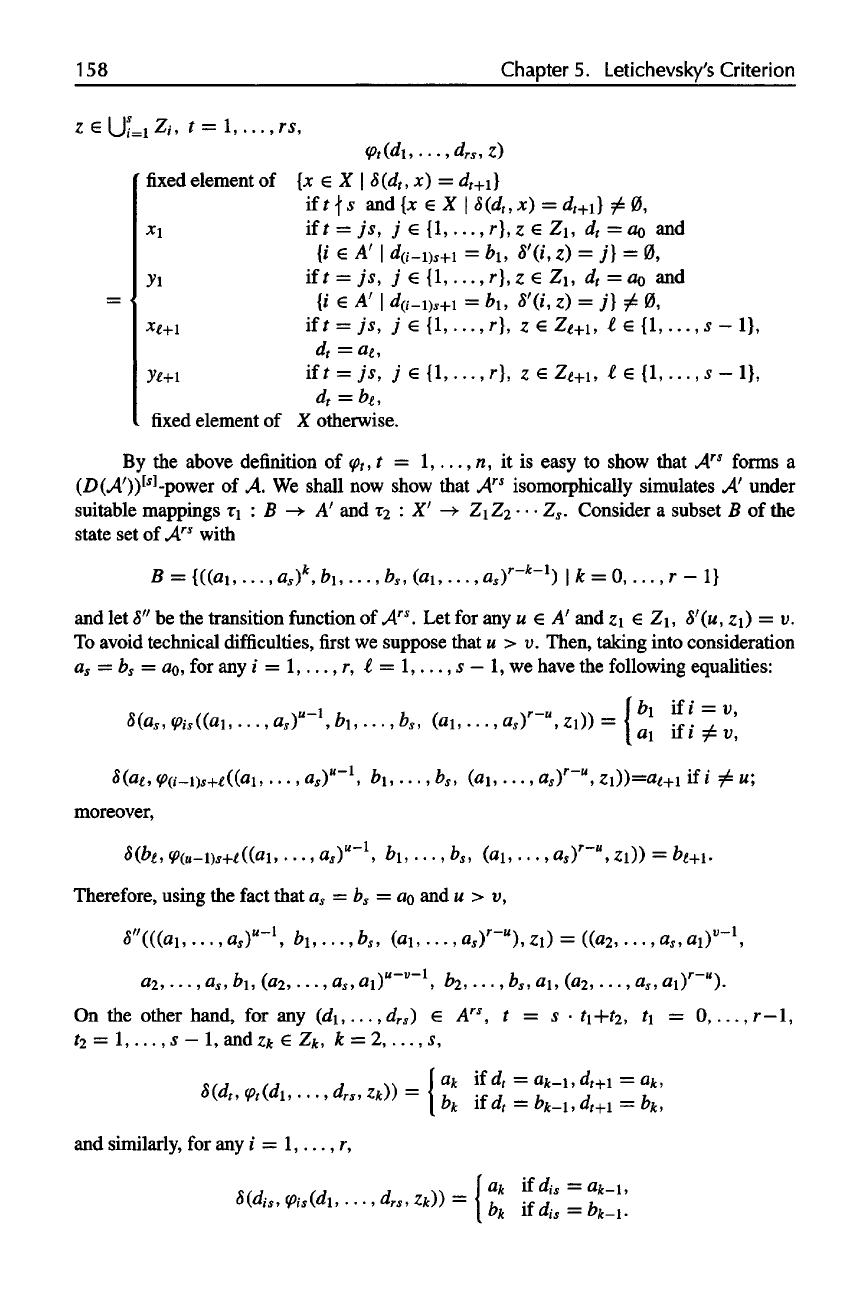
158
Chapters.
Letichevsky's
Criterion
By
the
above definition
of
t
, t =
1,...,«,
it is
easy
to
show that
A
rs
forms
a
(D(A
/
))
tsl
-power
of A. We
shall
now
show that
A
rs
isomorphically simulates
A
under
suitable mappings
: B A' and 2 : X'
Z\Z
2
---Z
s
.
Consider
a
subset
B of the
state
set of A
rs
with
and
let 8" be the
transition
function
of
A
rs
.
Let for any u A' and z
\
Z\,
8
f
(u,
z
\
) = v.
To
avoid technical
difficulties,
first we
suppose that
u > v.
Then, taking into consideration
a
s
= b
s
= ao, for any i =
1,...,
r, I =
1,...,
5
—
1, we
have
the
following equalities:
moreover,
Therefore, using
the
fact
that
a
s
= b
s
= a
o
and u > v,
On the
other hand,
for any
and
similarly,
for any i =
1,...,
r,
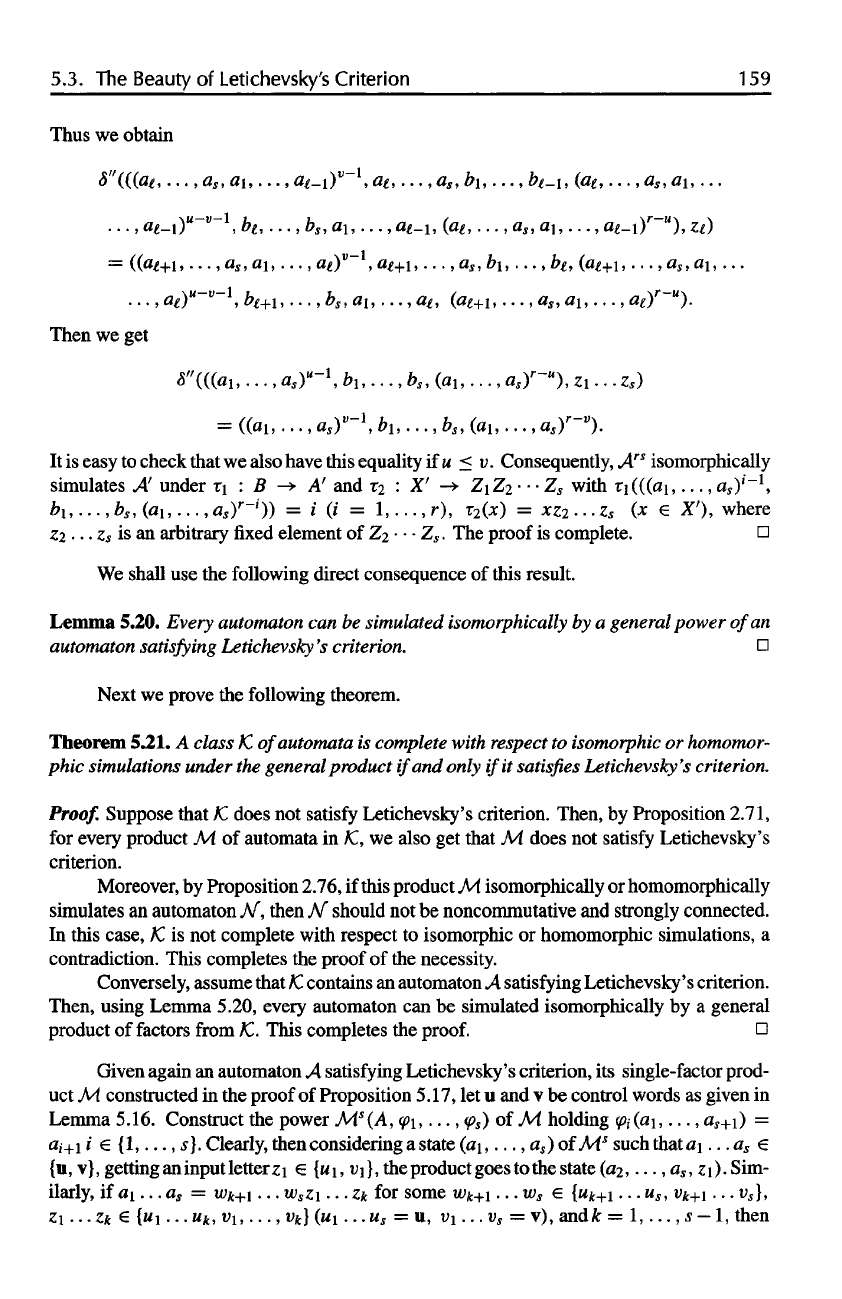
5.3.
The
Beauty
of
Letichevsky's
Criterion
159
Thus
we
obtain
Then
we get
It is
easy
to
check that
we
also have this equality
if u
Consequently,
A
rs
isomorphically
simulates
A'
under
and
with
where
Z
2
• • • z
s
is an
arbitrary
fixed
element
of Z
2
• • • Z
s
. The
proof
is
complete.
We
shall
use the
following direct consequence
of
this result.
Lemma 5.20.
Every
automaton
can be
simulated
isomorphically
by a
general power
of
an
automaton
satisfying
Letichevsky's
criterion.
Next
we
prove
the
following theorem.
Theorem
5.21.
A
class
k
of
automata
is
complete with
respect
to
isomorphic
or
homomor-
phic simulations
under
the
general product
if
and
only
if
it
satisfies
Letichevsky's
criterion.
Proof.
Suppose that
k
does
not
satisfy
Letichevsky's criterion. Then,
by
Proposition 2.71,
for
every product
M. of
automata
in /k, we
also
get
that
M.
does
not
satisfy
Letichevsky's
criterion.
Moreover,
by
Proposition 2.76,
if
this product
M
isomorphically
or
homomorphically
simulates
an
automaton
M,
then
N
should
not be
noncommutative
and
strongly connected.
In
this case,
k is not
complete with respect
to
isomorphic
or
homomorphic simulations,
a
contradiction. This completes
the
proof
of the
necessity.
Conversely, assume that
k
contains
an
automaton
A
satisfying Letichevsky's criterion.
Then, using Lemma 5.20, every automaton
can be
simulated isomorphically
by a
general
product
of
factors
from
k.
This
completes
the
proof.
Given
again
an
automaton
A
satisfying
Letichevsky's criterion,
its
single-factor prod-
uct
M
constructed
in the
proof
of
Proposition 5.17,
let u and v be
control words
as
given
in
Lemma 5.16. Construct
the
power
M
s
(A,
\
,...,
(
s
} of M
holding
i(a\,...,
a
s
+\)
=
a
i+
1
i
{1,...,
5}.
Clearly, then
considering
a
state
(a\,...,
a
s
)
of
M
s
such that
a\...
a
s
{u,
v},
getting
an
input letter
z
1
{u
1
, iv
1
},
the
product goes
to the
state (a
2
, ...,a
s
,z
1
). Sim-
ilarly,
if
for
some
1
and k
,
then
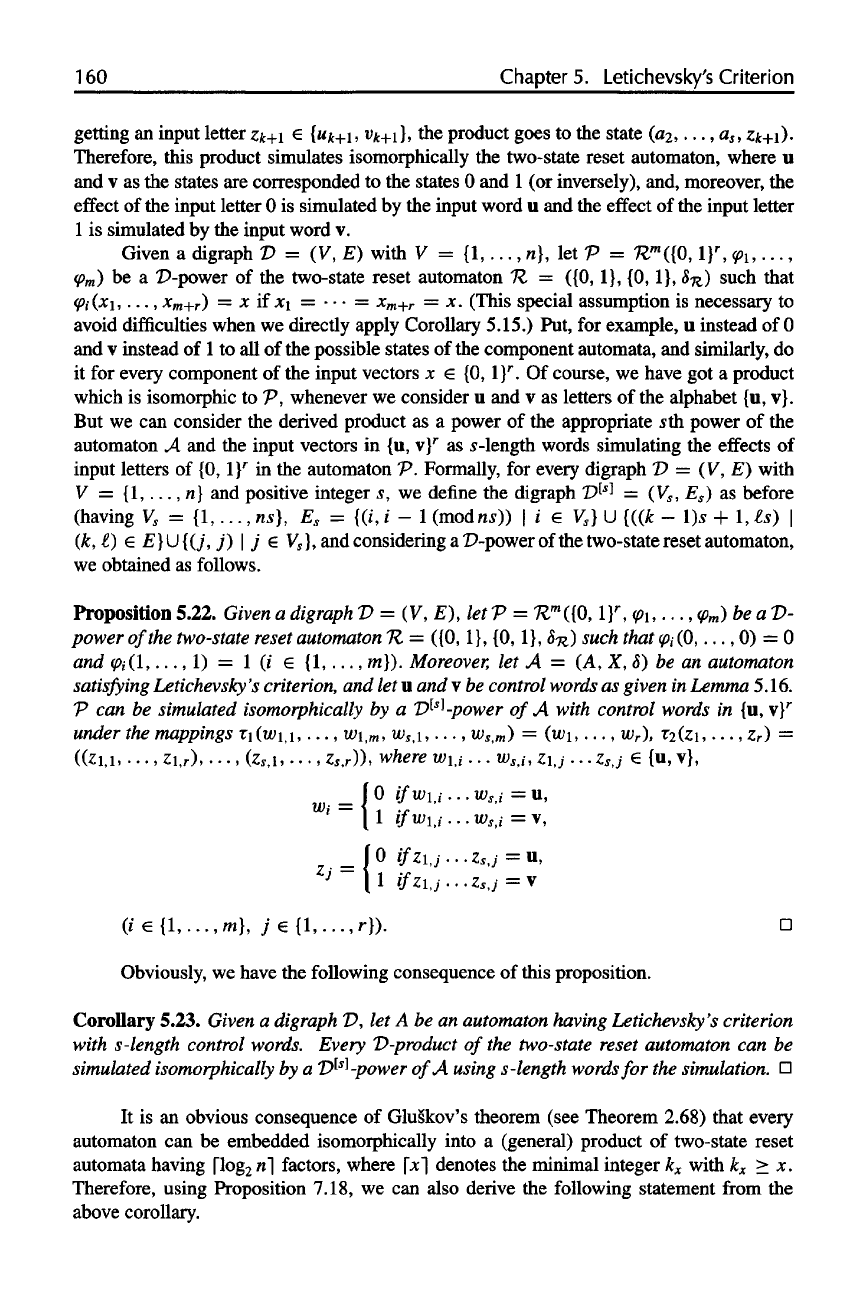
160
Chapter
5.
Letichevsky's
Criterion
getting
an
input letter
Zk+\
[uk+i,
Uk+l,
the
product goes
to the
state (a
2
,
...,a
s
,
Zk+i)-
Therefore,
this product simulates isomorphically
the
two-state reset automaton, where
u
and
v as the
states
are
corresponded
to the
states
0 and 1 (or
inversely), and, moreover,
the
effect
of the
input letter
0 is
simulated
by the
input word
u and the
effect
of the
input
letter
1 is
simulated
by the
input word
v.
Given
a
digraph
D = (V, E)
with
V =
{1,...,n},
let P =
R
m
({0,
l}
r
,
i,...,
m
) be a
D-power
of the
two-state reset automaton
R =
({0,
1}, {0, 1), S
R
)
such that
(pi
(x
1
,...,
x
m+r
)
= x if x\ = ••• =
x
m+r
= x.
(This special assumption
is
necessary
to
avoid
difficulties
when
we
directly apply Corollary
5.15.)
Put,
for
example,
u
instead
of 0
and
v
instead
of 1 to all of the
possible states
of the
component automata,
and
similarly,
do
it
for
every component
of the
input vectors
x {0,
l}
r
.
Of
course,
we
have
got a
product
which
is
isomorphic
to P,
whenever
we
consider
u and v as
letters
of the
alphabet
{u, v}.
But
we can
consider
the
derived product
as a
power
of the
appropriate
sth
power
of the
automaton
A and the
input vectors
in {u, v}
r
as
s-length words simulating
the
effects
of
input
letters
of {0, l}
r
in the
automaton
P.
Formally,
for
every digraph
D — (V, E)
with
V
=
[I,...
,n} and
positive integer
s, we
define
the
digraph
D
[s]
=
(V
s
,
E
s
) as
before
(having
V
s
=
{1,..., ns},
E
s
=
{(i,
/ - 1
(modns))
| i €
V
s
]
U
{((k
- l)s + 1, is) \
(k,£)
E}(u{(j,j)
| j €
V
s
],
and
considering
a
D-power
of the
two-state reset automaton,
we
obtained
as
follows.
Proposition
5.22. Given
a
digraph
D = (V, E), let P =
R
m
({0,
l}
r
,
lt
...,
m
) be a D-
powerofthe two-state
reset
automaton
R =
({0,
1},
{0,1},
8-
R
)
such
that(pi(0,...,
0) = 0
and
i(l,...,
1) = 1 (i €
{1,...,
m}).
Moreover,
let A = (A, X, 8) be an
automaton
satisfying
Letichevsky
's
criterion,
and let u and v be
control
words
as
given
in
Lemma 5.16.
P can be
simulated
isomorphically
by a
D
[s]
-power
of A
with control
words
in (u, v}
r
under
the
mappings
where
Obviously,
we
have
the
following consequence
of
this proposition.
Corollary
5.23. Given
a
digraph
D, let A be an
automaton having
Letichevsky's
criterion
with
s-length
control
words.
Every
D-product
of the
two-state
reset
automaton
can be
simulated
isomorphically
by a
D
[s]
-power
of
A
using
s-length
words
for the
simulation.
It is an
obvious consequence
of
Gluskov's theorem (see Theorem 2.68) that every
automaton
can be
embedded isomorphically into
a
(general) product
of
two-state
reset
automata
having flog
2
n] factors, where
[x]
denotes
the
minimal integer
k
x
with
k
x
x.
Therefore,
using Proposition 7.18,
we can
also derive
the
following statement
from
the
above
corollary.
